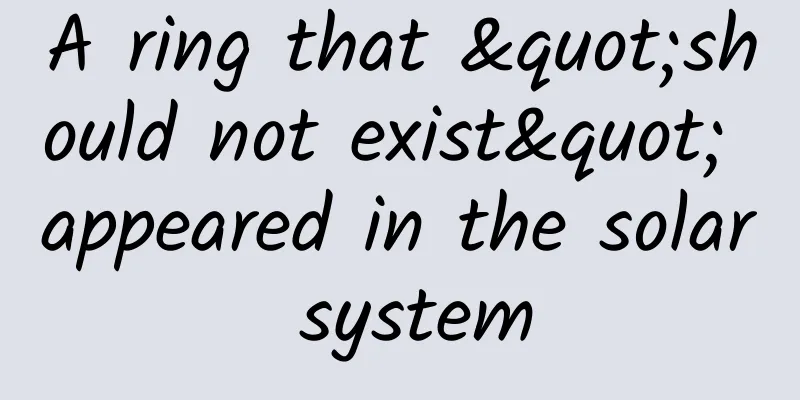A ring that "should not exist" appeared in the solar system

|
During a break from its observations of planets orbiting other stars, the European Space Agency's (ESA) Cheops (Characterising ExOPlanet Satellite) mission has made a decisive contribution to the discovery of an unexpectedly dense ring of material around a dwarf planet in our Solar System. The newly discovered rings are located at a distance of almost 7.5 times the radius of the dwarf planet, named Quaoar, which brings a new mystery to astronomers: Why didn't this material coalesce into a small satellite? Schematic diagram of Quaoar and its ring system. Image credit: ESA, CC BY-SA 3.0 IGO How to observe distant objects in the solar system Astronomers discovered the unexpected ring system through a series of observations conducted between 2018 and 2021. Using multiple ground-based telescopes and the space-based Exoplanet Characterization Explorer Satellite, astronomers watched Quaoar briefly block the light of a series of distant stars as it passed in front of them. This astronomical event is called an occultation. Observing how the light from the obscured star decreases can provide information about the size and shape of the obscuring object, and can also reveal whether it has an atmosphere. Unexpectedly, there were two more dips in brightness before and after the occultation, suggesting that there should be a ring system around Quaoar. But these rings are quite small and very faint. Quaoar is a trans-Neptunian object (TNO). Trans-Neptunian objects, also known as TNOs, are a series of small, distant objects, of which there are about 3,000 known. As the name implies, TNOs exist in the outer solar system, with orbits that are on average longer than Neptune's semi-major axis (30.1AU). Pluto and Eris are the largest known TNOs. Quaoar has an estimated radius of 555 km, making it the seventh largest known TNO, and has a small satellite named Weywot, which has a radius of about 80 km. Studying these dwarf planets is not easy because they are so small and so far away. Quaoar itself orbits the sun at a distance of almost 44 times that of the earth. Therefore, occultations are a particularly valuable tool for studying them. However, until recently, it was difficult for astronomers to predict exactly when and where they would occur. To observe an occultation, the alignment between the occulting object (in this case, a TNO), the star and the observing telescope must be extremely precise. In the past, this stringent accuracy requirement was almost impossible to meet and there was no guarantee that an occultation event would be observed. To achieve this goal, the European Research Council's Lucky Star project was created, coordinated by Bruno Sicardy, Sorbonne University and the Paris Observatory at the Laboratory of Space Sciences and Astrophysics Instrumentation (LESIA) at PSL, to predict upcoming TNO occultations and coordinate the observation of these events by professional and amateur observatories worldwide. Precise alignment The recent increase in the number of observed stellar occultations is largely due to data from ESA's star-mapping mission Gaia, which provides extremely precise data on the positions of stars, making the predictions made by the LuckyStar team even more certain. Kate Isaak, ESA's project scientist for the Exoplanet Characterization Satellite (ECS) mission, was curious whether space telescopes could also detect occultation events, so she contacted Isabella Pagano of the Astrophysical Observatory of Catania, the Italian National Institute for Astrophysics (INAF), a member of the ESA Exoplanet Characterization Satellite (ECS) mission management team and a member of the LuckyStar project. “I was a little skeptical about using the Exoplanet Characterization Satellite to do this,” Isabela admitted. “But we explored the feasibility.” The main problem is that the satellite's orbit can be slightly altered due to the drag of the Earth's upper atmosphere. This is due to unpredictable solar activity that hits the Earth, causing the Earth's atmosphere to expand. In fact, when the research team first tried to use EXOS to observe an occultation event involving Pluto, the predictions were not accurate enough and no occultation was observed. After a second alignment attempt, they observed Quaoar and, in the process, detected the first occultation of a star by a transoceanic object from space. See that ring Schematic diagram of the Exoplanet Characterization Satellite Image source: ESA / ATG medialab "The signal-to-noise ratio of the Exoplanet Characterization Explorer data is amazing," said Isabella. The signal-to-noise ratio is a measure of how strong the detected signal is relative to the random noise in the system. Exoplanet Characterization Explorer gives a good signal-to-noise ratio because its observations are not distorted by Earth's lower atmosphere. This high signal-to-noise ratio was decisive for identifying Quaoar's ring system, allowing the researchers to rule out the possibility that the dips in brightness were caused by interference from the Earth's atmosphere. By combining several secondary detections taken with ground-based telescopes, it was possible to determine that they were caused by the ring system around Quaoar. Bruno Morgado of the Federal University of Rio de Janeiro in Brazil led the analysis, combining data from the Exoplanet Characterization Explorer satellite with data from large professional observatories around the world and amateur citizen scientists who have observed various stars during Quaoar occultations over the past few years. "When we put all the data together, we saw that the dip in brightness was not caused by Quaoar itself, but pointed to the presence of some material in a circular orbit around it. As soon as we saw that, we said, 'OK, we see a ring around Quaoar.'" The research has been published in the journal Nature. When it comes to ring systems, the most famous are Saturn's rings. Saturn is known as a ringed planet, with a series of dust and small satellites orbiting the planet's equator. Saturn's rings are visually spectacular, but in fact they are a very small ring system, with a total mass of only one-third to one-half of Saturn's moon Mimas, or about half the mass of Earth's South Pole ice shelf. Quaoar's rings are much smaller than Saturn's, but no less intriguing. It's not the only ring system known to exist around a dwarf planet or asteroid; astronomers have discovered two others, around Chariklo and Haumea, using ground-based observations. However, what makes Quaoar's ring unique is its location relative to Quaoar itself. Beyond the Roche limit Any object with a significant gravitational field has a limit at which it is torn to pieces, known as the Roche limit. Dense ring systems would theoretically exist within the Roche limit, as is the case with Saturn, Chiron, and Haumea. "So what's so interesting about this discovery around Quaoar is that this ring is located further out than the Roche limit," said Giovanni Bruno of the Astrophysical Observatory of Catania, Italy's National Institute for Astrophysics. This is a mystery because according to conventional theory, rings that exceed the Roche limit will coalesce into a small satellite in just a few decades. "Based on our observations, the classical theory must be completely revised, that is, compact ring systems can only exist within the Roche limit of planetary bodies," Giovanni said. Early results suggest that Quaoar's extremely cold temperatures may play a role in preventing ice particles from sticking together, but more investigation is needed. "The EXOPS observations played a key role in confirming the presence of a ring system around Quaoar, going beyond the more typical exoplanet science of the mission in the application of high-precision photometry," said Kate. As theorists begin to work out how Quaoar's rings could exist, the LuckyStar project will continue to observe Quaoar and other TNOs, measuring their physical properties as they block the light of distant stars and seeing how many other TNOs also have ring systems. The Exoplanet Characterization Explorer satellite will return to its original mission and continue to study nearby exoplanets. About Exoplanet Characterization Satellite ESA is developing this mission with a dedicated consortium led by the University of Bern in Switzerland, with important contributions from Austria, Belgium, France, Germany, Hungary, Italy, Portugal, Spain, Sweden and the United Kingdom. ESA is the designer of the Exoplanet Characterization Satellite mission and is responsible for the procurement and testing of the satellite, its launch and early operations, its in-orbit commissioning, and the Guest Observers' Programme, to which scientists from all over the world can apply to make observations using Exoplanet Characterization Satellite. A consortium of 11 ESA Member States, led by Switzerland, provides the basic funding for the mission. The prime contractor for the design and construction of the spacecraft is Airbus Defence and Space in Madrid, Spain. |
<<: This rare pre-glacial plant was the "king of ferns" that lived at the same time as the dinosaurs
Recommend
What? Not only is there no New Year's Eve this year, but even the Nian beast is gone?
Whenever the Lunar New Year approaches, the legen...
Why can camels spit out meat balls from their mouths? What are these meat balls used for?
A dog cannot spit out ivory, which is an insult, ...
A heart-breaking question for holiday travel: Why is the signal on the high-speed rail so poor?
High-speed rail is an important symbol of the mod...
Mercedes-Benz G-Class launches two new models
The 2016 Guangzhou Auto Show has officially kicke...
The 110th anniversary of Qian Xuesen’s birth | What did he leave us?
Creative team: China Science and Technology Museu...
Online claw machine game to play YouTube advertising skills!
How to do foreign trade marketing for online claw...
There are early signs of Alzheimer's disease! Eating these can prevent it early
Talking about Alzheimer's disease The first i...
[Powerful] D3.js visualizes the number of SSH brute force attacks
This blog post is from 51CTO blogger Lao Xu_kevin...
If you don’t change these habits, osteoporosis may occur earlier! See if you are affected...
Many people think Osteoporosis is a problem only ...
How to plan physical store activities? Just read this one
How should physical stores organize activities to...
More than 660 alien species have invaded China
More than 660 alien species have invaded China (w...
Cold air is coming again! During the May Day holiday, there may be sandstorms in these places
The May Day holiday is coming soon Are you a litt...
A loud snore is no friend! Is a ventilator useful to get rid of snoring?
I saw some netizens saying that the elderly in th...
Is the Internet celebrity "eyewash" useful? Do you need to clean your eyes regularly? Ophthalmologists remind you →
Pour the eyewash solution in the small bottle int...
Talking about iOS large-scale project development
[[147407]] The title is a bit scary, please don&#...









